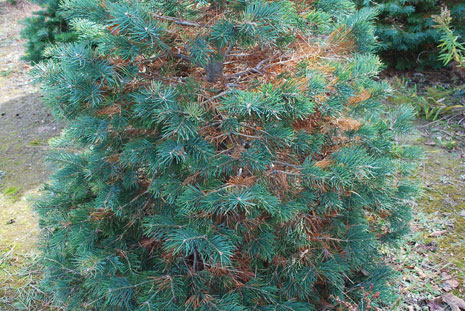Possible causes of interior needle shedding and trunk splitting of Fraser fir
Conifers shed needles under different circumstances. Here are some concerns to address if your Fraser firs are shedding or developing cracks in the trunk.
Each fall as harvest approaches, we get several calls about interior needles shedding on various species of Christmas trees. With some species like white and Scotch pine, the inner yellowing is a natural occurrence. Typically, these trees hold only 2 years of needles. In years where this happens over a longer period of time it becomes more noticeable and can cause concern.
In other trees like Fraser and Concolor fir, shedding interior needles in late September or October is unusual. What we have found is that shedding is occurring on the oldest interior needles and is either due to damaged needles from spider mite feeding or a symptom of trees under stress.
With mite damage the needles will show the characteristic “stippling.” When mites feed, they empty the cell of the green chlorophyll. This causes yellowish spots to occur, which are called stippling. Shedding from stress frequently happens after extended dry or hot periods in late August and September. When stress is the cause, it is usually on only 1 to 5 percent of trees in a field. If the cause is spider mites, you will want to develop a plan to manage these tiny pests next year. For other stress possibilities, evaluate the site and maybe take a soil sample to determine if you need to adjust your fertilizer program.
Also, we see a small number of cut Fraser fir where the trunk has split. Under certain conditions Fraser fir may develop a vertical crack starting at the base and extending up the trunk. This can happen during harvest on the farm, transporting, or on the retail lot. Trunk splitting is a function of rapid moisture loss from cut trees. According to Jeff Owen, Area Extension Specialist at North Carolina State University, “Full sun, high temperatures, and dry winds can pull moisture from the foliage of cut trees. While drought prior to cutting may be a contributing factor to the stresses that initiate cracks, the primary factor is exposure to conditions that dry the tree out rapidly.”
To minimize the potential of cracks developing at harvest provide conditions that help prevent moisture loss such as; increasing shade, humidity, and providing shelter from the wind. For more information, When trunks crack: What should you do? by Jeff Owen, North Carolina State University Extension.



 Print
Print Email
Email

